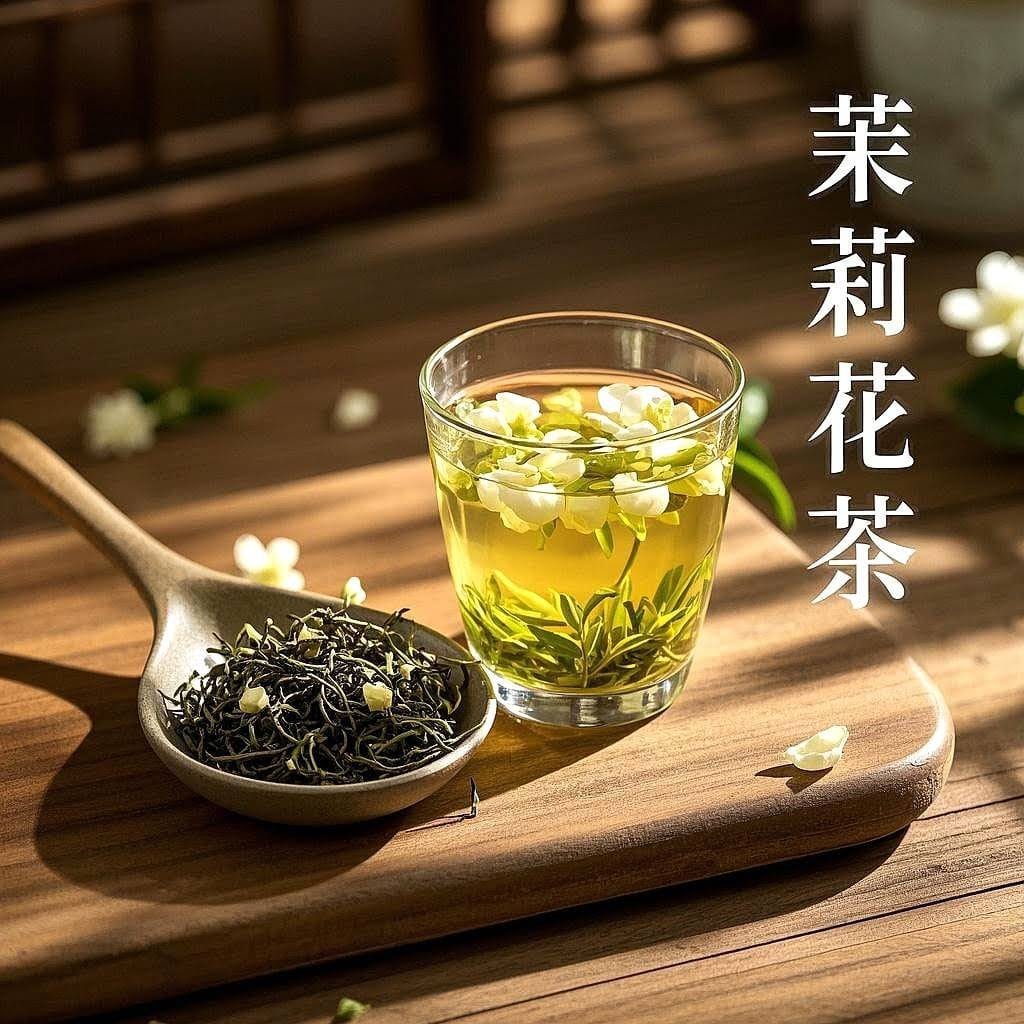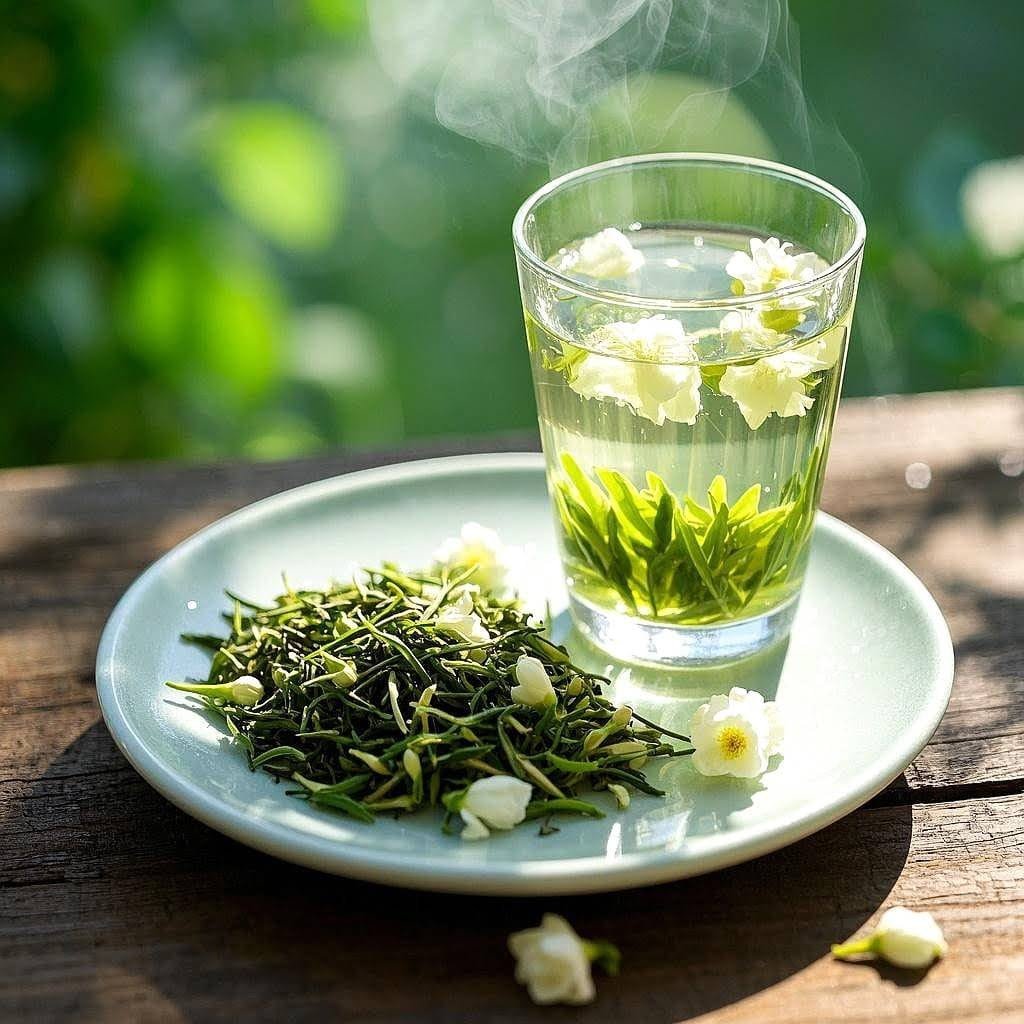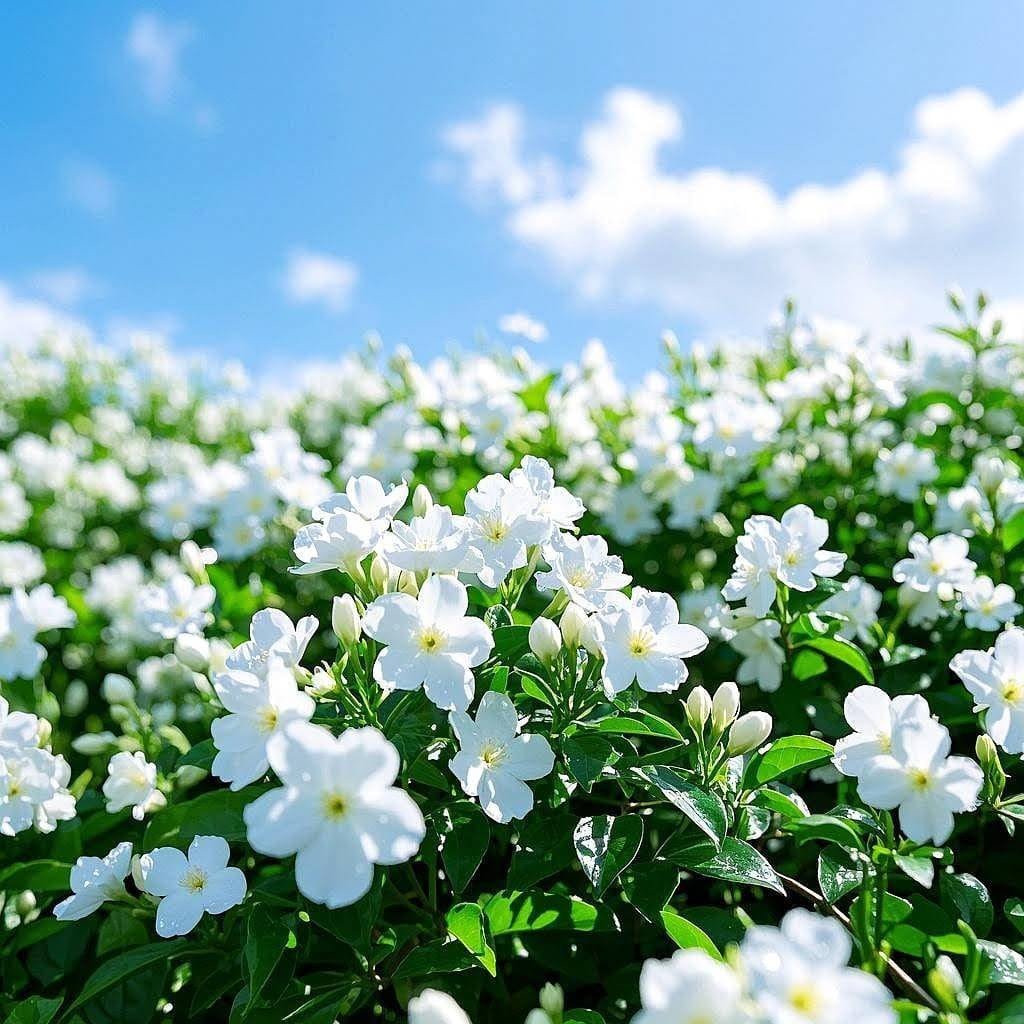Entering September, there is already a taste of autumn in the wind, and the jasmine flowers that have been fragrant for a whole summer are almost harvested, and the first cup of jasmine tea every year comes at this time. Most tea lovers believe that traditional Chinese jasmine tea bulk is the best way to make jasmine tea. Jasmine tea powder does not fully exploit the advantages of jasmine tea. Even in many tea suppliers around the world, in order to blindly pursue the aroma of jasmine and over-fry, the aroma of the tea itself is lost.

As a representative of reprocessed tea independent of the six major teas in China, jasmine tea has a history of thousands of years by sealing the fragrance of summer jasmine into spring tea buds with techniques such as blending and scenting.
As early as the Southern Song Dynasty (960 AD), there was a upsurge of “entering tea with fragrance” and improving the aroma of tea, and jasmine was one of the raw materials of spice tea appreciated by scholastic officials at that time.
By the end of the Ming Dynasty, Jasmine tea, which stood out among scented teas, began to be commercialized and popularized. During the Qing Dynasty, jasmine tea was imported into the tribute in bulk and scented on a large scale during the Xianfeng period, which was favored by the Empress Dowager Cixi.
It is because of the influence of the Qing court that jasmine tea has become one of the representatives of “Beijing flavor”, and old Beijingers are now also enjoying “jasmine tablets”! When you casually walk into an old Beijing teahouse, you will not be without the aroma of jasmine tea.
Not only that, there are many tea houses in Beijing that mainly sell jasmine tea, such as Zhang Yiyuan and Wu Yutai, which are famous and gradually set off the wind of jasmine tea drinking in northern China.
The jasmine tea that can be called the “top flow” of the north is actually mostly from the South, and it is a “North-South” tea! Whether it is the city teahouse, the new tea shop, or the state banquet temple, you can smell its fragrance, elegant and popular!
However, excellent jasmine tea cannot be separated from good jasmine flowers! Today, jasmine tea is produced in many southern provinces, the most representative of which are Fuzhou in Fujian, Hengzhou in Guangxi (formerly Hengxian), Qianwei in Sichuan and Yuanjiang in Yunnan.
The growth cycle of jasmine flowers in different producing areas is different, the tea billet and scenting process are also different, and the quality of jasmine tea is not the same! The four jasmine teas have their own abilities, which one is the best for your heart?

Fuzhou flower Mindong tea:The memory of rock candy sweet
In Fuzhou, the birthplace of jasmine tea in the world, to “jasmine” as the city flower, it has the meaning of “Mo away”, the familiar Fuzhou dialect “seven run-eight run-eight, never leave the tiger”, some people like to say “seven run-eight run-jasmine (Mo away) tiger.”
And that fresh and long, elegant rock sugar sweet jasmine tea loose, is countless old Fuzhou people in the memory of the unforgettable taste of home! Bing Xin, a famous female writer who was born in Fuzhou, loved jasmine tea all her life, and was often troubled by the jasmine tea in her hometown in her works.
“Overseas Chinese in Fujian are all over the world… Eating Fuzhou food and drinking jasmine tea in their homes and shops makes me feel that as a Fujianese, I have a home everywhere.” — My Parents’ Hometown by Bing Xin
“My hometown, Fujian, is both a tea country and the home of jasmine tea… Our family tradition is to drink jasmine tea…” The Hometown of Tea and the Jasmine Tea of My Hometown by Bing Xin
The reason why Fuzhou jasmine tea created in the Ming and Qing Dynasties is so difficult to give up is inseparable from the good flowers and tea! The raw materials of traditional jasmine tea should follow a sentence: “Fuzhou flower, Mindong tea”.
Every spring, Fuzhou people began to select high-quality baked green tea produced in Mindong (mostly Fuding white tea, Fuding Dahao tea as the main raw materials) as tea billet.
Due to the high amino acid content of Fuding Dahao tea and Fuding Dahao tea, the baked green tea made by Mindong ingenuity is fresh and sweet. After strict storage, it is waiting for Fuzhou jasmine flowers to bloom in summer.
The flowering period of Fuzhou jasmine is 5-August, and the jasmine used for scenting is also required! Jasmine flower has single petal, double petal, cluster petal, single petal jasmine and double petal jasmine flower outstanding performance, is the first choice for Fuzhou people to make tea flower material.
The single-petal jasmine, which is rooted in the two banks of Minjiang River, is the best flower material for scenting, but its yield is scarce, and it is mostly used for scenting high-end Fuzhou Jasmine tea. Double petal jasmine is the main jasmine tea in Fuzhou.
The growth cycle of jasminum tubulosum is long, the aroma is weak, and the yield is not high, so it is rarely used for scenting scented tea. Good raw materials laid the material foundation, whether the perfect realization of “tea fragrance, to benefit the flavor of tea”, can not be separated from the exquisite scenting process!
Fuzhou Jasmine tea, created in the Ming and Qing dynasties, has a long history of scenting and has been developed so far with skilled scenting skills that it was included in the fourth batch of national intangible cultural Heritage representative projects list in 2014.
The scenting process of jasmine tea in Fuzhou includes seven processes: leveling, shaking, wading, worshiping, baking, scenting, and lifting, and requires that the flowers are not scenting on sunny days, and the flowers are removed after scenting each time, and then baking and standing for about three days to observe the stability of the endoplasm before starting a new round of scenting.
The scenting ratio of camellia is usually 1:3, (1 jin tea, 3 jin flower), and the scenting time is also required, generally at least four scenting times to be called Fuzhou Jasmine tea.
The best Fuzhou jasmine tea is the selection of “dog days” picked jasmine flowers, after six to eight scenting. But the number of scenting is also capped, nine scenting is the ceiling level!
After nine scenting flowers, the best Fuzhou jasmine tea is fresh and fragrant, jasmine fragrance is long and lasting, the entrance is fresh and smooth, the unique rock sugar is sweet, and it still has lingering fragrance after a long soak.
It is the three pronged combination of Fujian good tea billet, Fuzhou high-quality jasmine flower, and the scenting process that has been inherited for a long time, and the Fuzhou Jasmine tea that “smells flowers and does not see flowers, and is unique and sweet with rock sugar” can make people drink it and forget it.

Hengzhou jasmine tea:Production ranks first in the world
Throughout today, the center of gravity of the national jasmine tea industry in Hengzhou, “the world every year 10 cups of jasmine tea, 6 cups produced in Hengzhou” this sentence is not exaggerated!
Hengzhou Jasmine tea was created in 1978. In the late 1980s and early 1990s, with the support of the local government, the scale of Hengzhou Jasmine tea continued to expand, breaking the situation that Fuzhou Jasmine tea had dominated China for hundreds of years.
Up to now, Hengzhou, which blooms from early summer to late autumn (April-October) every year, has not only become the hometown of jasmine tea in China, but also the world’s largest production base for economic use of jasmine and the world’s jasmine tea production center!
In 2023, Hengzhou planted 131,000 mu of jasmine, the annual output of flowers reached 103,000 tons, and the annual output of jasmine tea 80,000 tons, far ahead of the other three major producing areas, is the absolute representative of modern jasmine industry.
In addition to the first unshakable output, Hengxian Jasmine tea technology exquisite, high quality! General tea billets were made of local Guangxi large leaf seed roasted green tea made in spring, mixed with double-valve jasmine picked from Hengzhou in mid-summer for scenting.
Usually picked flowers should be held in breathable baskets or mesh bags in time for maintenance, and must be scented within 5 to 10 hours. However, before this, it is necessary to dry the tea billets that have been stored for a long time.
Then it is made by the process of camellia combination → pile scenting → pass scenting → flower initiation → drying → jacquard → sifting. Finally, it is necessary to sample and test in time when the flower is raised. After the quality is up to standard, it is packed and bagged for sale.
Carefully made of Hengxian County Jasmine tea dry tea rope tight and uniform, smell of fresh flowers, lasting and not dispersed, into the cup after brewing taste fresh, rich and pure, long-bubbling leaf base tender and even, good quality, cost-effective is also high.

Sichuan style “fried flower” technology:See the tea see the flower fragrance high taste strong
Qianwei County in Sichuan Province has the second largest jasmine field in the country, and the jasmine planting area is second only to Hengzhou. Jasmine is the “county flower” in Qianwei, with a history of more than 300 years of jasmine planting.
Different regions have different climatic environments, and the flowering period of jasmine flowers is not the same. The jasmine flowering period of Qianwei County is from May to September, which is much shorter than the flowering period of Hengzhou, and the output is also a big difference.
However, thanks to the favorable soil and water conditions of the “land of abundance”, Qianwei Jasmine flowers show the characteristics of large buds, thick petals and net flowers, and introduce more than 40 kinds of jasmine flowers at home and abroad, which is recognized as the most jasmine varieties in the country.
Rich variety creates the diversity of flowers, production is also unique! The traditional baked green tea is also used for scenting, but the unique Sichuan style “fried flower” process is refined by combining the characteristics of local flower materials.
The so-called “fried flower” is to screen out the jasmine flowers that are repeatedly scenting and lose their aroma after scenting is over, and then sprinkle the jasmine flowers that are removed from the receptions, and continue to stir tea and flowers together to further integrate the tea aroma and fragrance.
This allows Sichuan jasmine tea to form a rare type of jasmine tea that “sees tea and flowers” in bulk. The most famous one is Bitan Xiaoxue. After brewing, the blossoming jasmine flowers spread out, just like the drifting snow in the pool, with high aroma and strong taste and fresh taste.

Yuanjiang Jasmine is very rare:The earliest jasmine producing area
Yuanjiang in Yunnan Province is the lowest among the four major jasmine tea producing areas. The annual output of jasmine tea here ranks the last, but the flower period of Jasmine is the earliest and longest, usually blooming in March and lasting until November.
This is inseparable from the unique local climate and environment. Yuanjiang is a famous dry and hot river valley in Yunnan Province. The temperature warms faster in early spring, which pushes the accelerator button for the growth of jasmine and makes the first cup of jasmine tea every year.
Yuanjiang Jasmine flowers with thick petals and large buds smell rich and fragrant, so they are mostly made into luzhou-scented jasmine tea, while Yuanjiang jasmine tea with three scenting is the mainstream, the entrance is slightly bitter, the soup feeling is full and warm, and the foam resistance is outstanding.
However, the jasmine tea industry in Yuanjiang is declining, mainly because of the low economic benefits of growing jasmine locally. In order to survive, many flower farmers have switched to other industries, so the planting area of Yunnan jasmine is gradually reduced, and the output is naturally not high.
In addition to Fuzhou in Fujian Province, Hengzhou in Guangxi Province, Qianwei in Sichuan Province and Yuanjiang in Yunnan Province, jasmine tea is also produced in Jinhua in Zhejiang Province, Suzhou in Jiangsu Province, Fuding in Fujian Province and Qionglai in Sichuan Province.
The jasmine tea bulk produced by our tea mountain is scenting with the jasmine flowers from Qianwei, Sichuan Province and the organic wild tea on the mountain. We adopt the traditional technology, and will not excessively pursue the jasmine fragrance. Only in this way can the jasmine tea fragrance and floral fragrance achieve a best integration. If you would like to try our jasmine tea bulk, please check out the link below.
jasmine tea
Carefully selected high-quality tea leaves and fresh jasmine flowers, repeatedly aged. The tea soup is clear, with fragrant flowers and a refreshing taste. Let you enjoy a moment of peaceful tea fragrance in your busy life.
Weight: 2 oz



